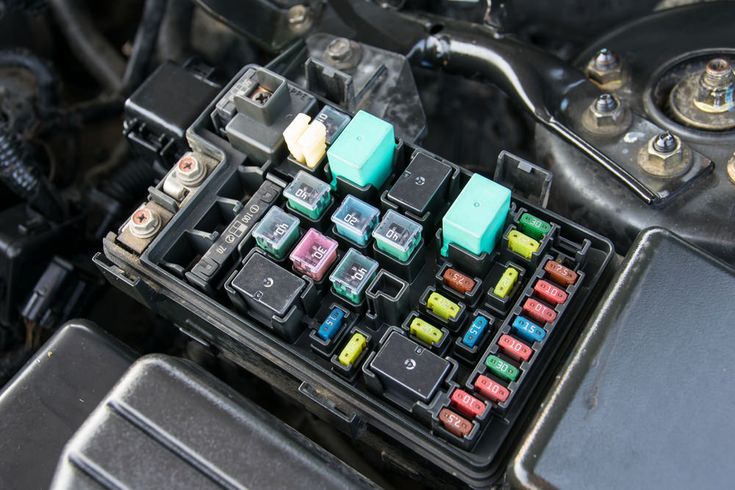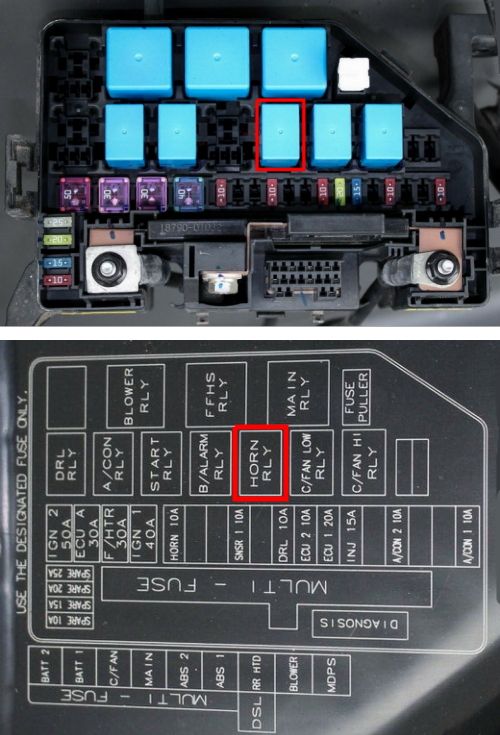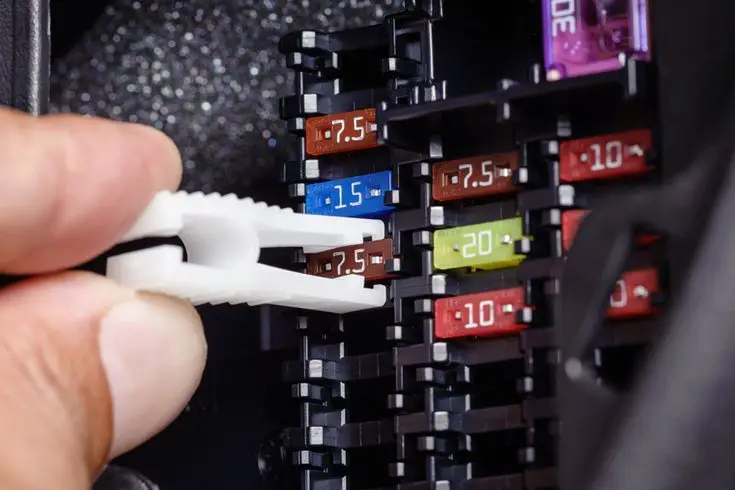Encountering a blown fuse in your car can be frustrating, but fixing it is simpler than most people think. When your car’s electrical components suddenly stop working, a blown fuse is often the culprit. Replacing a car fuse requires just a few basic tools and can be completed in about 10 minutes by following the right steps.

Finding and fixing a blown fuse starts with locating your car’s fuse box, which is typically under the dashboard or in the engine compartment. Before attempting any repairs, it’s important to turn off your engine and disconnect the battery to prevent electrical accidents. Once you’ve identified the faulty fuse by its broken metal strip inside, you can remove it carefully and replace it with a new one of the exact same amperage rating.
Key Takeaways
- Always replace blown fuses with new ones of identical amperage to prevent electrical system damage.
- Locating your car’s fuse box and turning off the engine are essential first safety steps.
- Regular inspection of your car’s electrical system can prevent unexpected fuse failures.
Understanding Fuses in Cars

Fuses are crucial safety components in your vehicle’s electrical system. They protect wiring and electrical components from damage by breaking the circuit when too much current flows through.
Types of Automotive Fuses
Modern vehicles typically use several types of fuses, each with specific applications. The most common are blade-type fuses, which come in different sizes and colors that indicate their amperage rating.
Standard blade fuses include:
- Mini fuses (small, rectangular)
- Regular blade fuses (slightly larger)
- Maxi fuses (for higher current applications)

Older vehicles may use glass fuses, which have a glass cylinder with metal caps on each end. These are becoming less common in newer vehicles.
Some high-current applications use cartridge fuses or fusible links. These handle larger electrical loads for components like alternators or main power distribution.

Each fuse type is color-coded according to its amperage rating, making identification easier when replacement is needed.
Functions of Fuses and Fuse Boxes
The primary purpose of fuses is to act as “weak links” that fail safely before electrical problems damage expensive components. When electrical current exceeds a fuse’s rating, it blows to prevent fire or damage.
Fuse boxes house multiple fuses in organized, accessible locations. Most vehicles have at least two:
- A main fuse box under the hood for high-current systems
- An interior fuse box (often under the dashboard) for cabin electronics
Each fuse protects a specific circuit or component. For example, separate fuses protect headlights, radio, power windows, and fuel pump circuits.
The fuse box cover typically includes a diagram identifying each fuse’s function and amperage rating. This makes troubleshooting easier when electrical problems occur.
Common Causes of Blown Fuses
Fuses blow when too much current flows through them. Several common scenarios can cause this:
Short circuits occur when a wire’s insulation fails, allowing current to flow through an unintended path. This quickly overloads the fuse, causing it to blow.
Overloaded circuits happen when too many accessories draw power from one circuit. This is common with aftermarket installations like powerful stereos or extra lights.
Faulty components with internal shorts can draw excessive current. Examples include damaged motors in power windows or seats.
Water damage can create short circuits when moisture reaches electrical connections. This often happens after driving through floods or car washes.
Repeatedly blown fuses in the same position indicate an underlying problem that requires diagnosis, not just fuse replacement.
How to Identify a Blown Fuse

Identifying a blown fuse is crucial before attempting replacement. A blown fuse has specific visual indicators and its failure causes noticeable symptoms in your vehicle’s electrical systems.
Symptoms of a Blown Fuse
When a fuse blows in your car, you’ll notice specific electrical components stop working. This could include headlights, power windows, radio, or dashboard controls. Often, related systems fail together if they share the same fuse.
One clear sign is when an electrical component suddenly stops working while others function normally. For example, if your radio and interior lights stop working at the same time, they likely share a blown fuse.
Another indicator might be intermittent function – a component works sometimes but fails at other times. This suggests a fuse that’s damaged but not completely blown.
Before replacing any fuse, always check if multiple systems are affected to help identify which fuse might be responsible.
Using a Multimeter to Test Fuses
A multimeter offers the most reliable way to test for a blown fuse. Set your multimeter to the continuity setting (often marked with a sound wave symbol) or to measure resistance (ohms).
Steps to test a fuse:
- Remove the suspected fuse carefully using fuse pullers or tweezers
- Touch one multimeter probe to each metal end of the fuse
- Check the reading: good fuses show continuity (near zero ohms), while blown fuses show infinite resistance
You can also perform a visual inspection. Most car fuses are transparent, allowing you to see if the metal strip inside is intact or broken. A broken strip confirms a blown fuse.
For quick testing without removing fuses, a test light can locate blown fuses by touching the exposed metal contacts on the top of each fuse.
Locating Your Car’s Fuse Box

Before you can replace a blown fuse, you need to find where your car’s fuse box is hiding. Most vehicles have two fuse boxes—one inside the car and another under the hood.
Finding the Fuse Panel in Different Vehicles
Most cars have two fuse boxes in standard locations. The interior fuse box is typically located on the driver’s side of the dashboard. Look for a small door or panel that you can pull open, usually near your knees or to the left of the steering wheel.
The second fuse box is usually under the hood near the battery or along one of the fender walls. This box contains fuses for major systems like your engine, cooling, and headlights.
In some vehicles, you might find additional fuse boxes. SUVs and larger vehicles sometimes have a third fuse box under the rear seat or in the cargo area.
European cars often place interior fuse panels in less obvious spots, such as inside the glove compartment or in a side panel of the center console.
Decoding the Fuse Box Diagram
Once you locate the fuse panel, you’ll see a diagram on the inside of the cover. This diagram is your map to the fuse box’s contents.

The diagram shows the layout of all fuses and what each one controls. Fuses are typically arranged in rows with numbers or symbols identifying each position.
Each fuse controls a specific electrical component or system in your car. The diagram will show which fuse protects which system—like “Radio,” “Door Locks,” or “Tail Lights.”
Pay attention to the amperage ratings listed next to each fuse position. These numbers (like 5, 10, 15, or 20) tell you the correct rating for the replacement fuse.
Some diagrams use color coding to help identify fuse types. Yellow often indicates 20-amp fuses, while blue might represent 15-amp fuses.
Consulting the Owner’s Manual
Your car’s owner’s manual provides detailed information about your fuse box locations. The manual typically contains a dedicated section about electrical systems and fuse replacement.
The manual includes comprehensive diagrams showing both interior and engine compartment fuse panels. These diagrams are often more detailed than those on the fuse box cover.
Many manuals list each fuse by number and function in a table format. This makes it easy to find exactly which fuse you need to check or replace.
If you’ve lost your owner’s manual, most manufacturers offer digital versions on their websites. Simply search for your vehicle make, model, and year followed by “owner’s manual.”

For older vehicles, online forums dedicated to your specific car model can provide valuable information about unusual fuse box locations that might not be obvious.
Choosing the Right Replacement Fuse

Selecting the correct fuse is critical for your vehicle’s electrical system safety. Using the wrong type or amperage can lead to electrical failures or even fires.
Selecting the Correct Fuse Type
Most modern vehicles use blade-type fuses, which feature a plastic housing with metal prongs. These come in several sizes including mini, standard, and maxi. Check your owner’s manual to determine which type your car requires.
Some older vehicles might use glass fuses that have a glass cylinder with metal caps on each end. These are less common in today’s vehicles but still found in certain models.
When replacing a fuse, always match the exact type. Using an incorrect fuse style may result in poor connection or inability to fit in the fuse box properly.
Automotive fuses are specifically designed for vehicle electrical systems and shouldn’t be substituted with household fuses. Keep a small assortment of common fuse types in your glove compartment for emergencies.
Amperage Ratings and Color Codes
The amperage rating is the most important specification when choosing a replacement fuse. This number indicates how much current the fuse can handle before blowing.
Always match the exact amperage rating of the blown fuse. Using a lower rating may cause the fuse to blow prematurely, while using a higher rating could allow excessive current that damages components or causes fires.
Automotive fuses follow a standard color-coding system to indicate amperage:
- Dark blue: 15 amps
- Yellow: 20 amps
- Clear/white: 25 amps
- Green: 30 amps
- Orange: 40 amps
The amperage value is also printed directly on the top of most fuses. Before removing the blown fuse, note its color and rating, then purchase an identical replacement.
Step-by-Step Guide to Replacing a Blown Fuse

Replacing a car fuse is a simple maintenance task that can save you time and money. The process involves identifying the blown fuse, removing it safely, and installing the correct replacement.
Gathering Tools and Safety Precautions
Before starting any electrical work on your vehicle, safety should be your top priority. Turn off the engine and remove the key from the ignition to prevent electrical accidents.
Tools you’ll need:
- Owner’s manual
- Fuse puller or small tweezers
- Flashlight
- Replacement fuses of various amperage ratings
Your car’s owner’s manual contains important information about fuse locations and ratings. Keep it handy during the process.
Purchase a variety of replacement fuses beforehand. They’re inexpensive and come in different amperage ratings marked by numbers on top.
A dedicated fuse puller is often included in your car’s fuse box. If you can’t find one, small tweezers or needle-nose pliers can work as substitutes.
Removing the Faulty Fuse
Locate the fuse box, which is typically found under the dashboard on the driver’s side or in the engine compartment. Some vehicles have multiple fuse boxes.
Remove the fuse box cover carefully. You’ll often find a diagram on the inside of the cover showing the function of each fuse.
Identify the blown fuse by looking for a broken metal filament inside or discoloration. A visual inspection will reveal if the metal strip inside is broken.
Grip the fuse firmly with your fuse puller or tweezers and pull it straight out of the fuse block. Don’t twist or wiggle excessively as this might damage the connections.
If you’re unsure which fuse is blown, consult your car’s manual or use the diagram on the fuse box cover to identify the problematic circuit.
Installing a New Fuse
Select a replacement fuse with the exact same amperage rating as the one you removed. Using a fuse with a higher amperage rating can damage your car’s electrical system or even cause a fire.
Hold the new fuse by its plastic body, align it with the empty slot in the fuse block, and press it firmly into place. Ensure it’s seated properly and flush with other fuses.
Test the component that wasn’t working to confirm you’ve resolved the issue. If the new fuse blows immediately, there may be a more serious electrical problem.
Replace the fuse box cover and ensure it snaps securely into place. This protects the fuses from moisture and debris.
Make a note of which fuse you replaced and when. This information can be useful for tracking recurring electrical issues in your vehicle.
Troubleshooting Electrical Problems After Replacement

Sometimes replacing a fuse doesn’t fix the problem, or the new fuse blows immediately. This usually indicates an underlying electrical issue that needs further investigation to prevent continuous fuse failures.
Checking for Recurring Electrical Issues
If a replaced fuse blows immediately, you likely have a short circuit or another electrical fault. A blown fuse usually has a broken wire or burnt appearance inside, making visual inspection helpful.
First, ensure you’re using the correct amperage fuse. Always replace fuses with the same amperage rating as the original to maintain electrical integrity.
Check which components are on the affected circuit by consulting your vehicle’s manual. Turn off all related accessories and try replacing the fuse again.
Test one component at a time by turning on accessories individually after replacement. If the fuse blows when activating a specific component, that item is likely causing the problem.
For recurring issues, use a multimeter to test for unusual current draws. Set it to measure amps and connect it in series with the fuse location to identify excessive current.
Inspecting Electrical Wiring
Damaged wiring often causes persistent electrical problems. Broken bulb filaments can cause shorts to ground, so remove and check all bulbs on the affected circuit.
Look for these common wiring issues:
- Frayed wires: Inspect for exposed wire where insulation has worn away
- Pinched cables: Check areas where wiring passes through tight spaces
- Corroded connections: Look for green buildup or rust at connection points
- Water damage: Examine for signs of moisture in connectors or junction boxes
Follow wiring harnesses from the fuse box to components, paying special attention to areas near moving parts or heat sources. These areas frequently experience wear.
Use a circuit tester to check for continuity and proper grounding. Disconnect the battery before handling any wiring to prevent shorts or electrical shock.
If you can’t locate the issue, consider having a professional mechanic perform a thorough electrical diagnostic. Complex electrical problems often require specialized testing equipment.
Maintaining and Protecting Your Car’s Electrical System

A well-maintained electrical system prevents unexpected breakdowns and extends your vehicle’s life. Regular inspections and proper care can save you time and money on repairs.
Preventing Future Fuse Failures
Regular inspection of your fuse box helps identify potential issues before they cause problems. Replace blown fuses promptly, as they indicate underlying electrical problems.
Check for loose connections in electrical components. Vibration during driving can gradually loosen wires and connections.
Avoid overloading circuits by using only manufacturer-recommended accessories. Aftermarket additions like powerful stereos or extra lighting can strain your car’s electrical system.
Keep battery terminals clean and tight. Corrosion at the terminals creates resistance that forces other electrical components to work harder.
Have your alternator checked during routine maintenance. A failing alternator can cause voltage fluctuations that blow fuses repeatedly.
Using Dielectric Grease for Corrosion Protection
Dielectric grease is essential for protecting electrical connections. This silicone-based substance prevents moisture and contaminants from reaching metal contacts.
Apply a small amount to:
- Battery terminals
- Spark plug boots
- Headlight connectors
- Fuse box connections
The grease creates a waterproof seal while allowing electricity to flow unimpeded. It’s especially important in humid or coastal environments where corrosion happens quickly.
When applying, use a clean microfiber cloth or small brush. A little goes a long way—excessive amounts can actually prevent good contact.
Reapply dielectric grease annually or when servicing electrical components. This simple maintenance step prevents many electrical failures.
Essential Tools for Electrical Maintenance
Every car owner should have basic electrical maintenance tools. A multimeter tests voltage, resistance, and continuity to diagnose electrical problems accurately.
A quality wire stripper allows for clean removal of insulation when repairing damaged wires. Look for one with multiple gauge settings for different wire sizes.
Crimp connectors and a crimping tool enable secure wire repairs without a soldering iron, though soldering creates more permanent connections.
Keep these items in your toolkit:
- Fuse puller
- Assortment of replacement fuses
- Electrical tape
- Wire ties for organization
A small LED flashlight or headlamp helps when working in dimly lit areas like under the dashboard. Magnetic tools prevent dropped screws in hard-to-reach places.
Frequently Asked Questions

Replacing a blown fuse in your car involves specific steps and tools that help diagnose electrical issues quickly. Car fuses protect electrical components from damage when circuits overload or short circuit.
What are the steps to replace a blown fuse in a car?
Replacing a blown fuse involves several straightforward steps. First, turn off your vehicle completely before attempting any fuse replacement to avoid electrical hazards.
Locate your car’s fuse box, which is typically found under the dashboard, in the glove compartment, or under the hood. Your owner’s manual can provide the exact location.
Identify the blown fuse by checking for a broken metal strip inside or discoloration. Remove the blown fuse using a fuse puller or needle-nose pliers.
Replace it with a new fuse of the same amperage rating. Never substitute a fuse with one of a higher rating as this could damage your electrical system.
Where can I find a guide for fixing a blown fuse in my car’s cigarette lighter?
Most owner’s manuals contain information about fuse locations specific to your vehicle, including the cigarette lighter fuse. This fuse is commonly labeled as “power outlet” or “accessory power” in the fuse box diagram.
The cigarette lighter fuse is typically located in the interior fuse box. Replacing this fuse follows the same procedure as any other fuse—identify, remove, and replace with an identical amperage fuse.
Can you provide instructions on safely removing a fuse from a car’s fuse box?
To safely remove a fuse, ensure the vehicle is off and the key is removed from the ignition. This prevents any electrical current from flowing through the system while you work.
Use a fuse puller tool if one was included with your vehicle. These plastic tools are designed to grip fuses securely without damaging the fuse box.
If you don’t have a fuse puller, needle-nose pliers work well. Grip the fuse firmly but gently and pull straight up with even pressure to avoid breaking the fuse or damaging the socket.
What should I do to fix a blown fuse in my car’s radio?
First, consult your owner’s manual to locate the fuse that controls the radio circuit. This is typically found in the interior fuse panel.
Once located, examine the fuse for signs of failure such as a broken metal strip or black marks. If blown, remove it carefully using a fuse puller or pliers.
Install a new fuse with the exact same amperage rating. If the replacement fuse blows immediately, this indicates a larger electrical problem that may require professional diagnosis.
How do I locate and use a fuse puller for car fuse replacement?
Many vehicles include a small plastic fuse puller tool, often stored within the fuse box cover. This specialized tool makes fuse removal safer and easier.
To use a fuse puller, position the forked end around the body of the fuse you want to remove. Apply gentle upward pressure to pull the fuse straight out of its socket.
If your vehicle doesn’t have a fuse puller, you can purchase one at auto parts stores or use small needle-nose pliers as an alternative.
What common indications suggest I may have a blown fuse in my car?
A sudden failure of an electrical component while others continue to function normally often indicates a blown fuse. For example, if your power windows stop working but your headlights still operate.
Interior lights, dashboard indicators, or entertainment systems that unexpectedly stop working are common signs of fuse problems.
Multiple electrical components failing simultaneously might indicate a more serious electrical issue beyond a simple fuse replacement. In this case, professional diagnosis is recommended.



